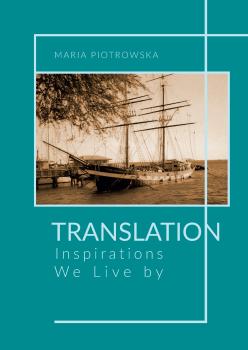Translation: Inspirations We Live by
Keywords:
ethnography of translation, history of translation, intuition, metaphor, palimpsest, translator competence, translator’s decision-making, translation research, Translation StudiesSynopsis
The main aim of the book is not only a historical and contemporary overview of translation research models and methods but also the author’s critical analysis of the state of the art in Translation Studies and a commentary of the progress of the discipline; as indicated in the chapter titles, which are called “Reflections.” The monograph is structured around seven major areas of reflection upon translation and the field of multi-dimensional translation research, and its particular chapters concern chronologically: translation metaphors, historical perspectives on translation, translation – culture interrelations, with particular focus on ethnography of translation; translator competence, translator’s decision-making and intuition. The last chapter offers “a map of Translation Studies”, which demonstrates its dynamism, diversity, complexity, inter- and multidisciplinarity. The palimpsest metaphor that concludes translation reflections and refers back to the first chapter, defines translation as a complex sequence of experiential layers and inspirations “we live by”, as indicated in the title of the classic of cognitive linguistics by Lakoff and Johnson (1980), which the monograph title alludes to.
Chapters
-
TABLE OF CONTENTS
-
INTRODUCTION: PLAYING WITH DATA
-
0.1. Translation in the Spotlight of Scholarly Interest – the Approach and Scope of Research .......... 17
-
0.2. Terms .......... 17
-
0.3. Playing with Data .......... 18
-
0.4. Structure of the Book Based on Seven Reflections .......... 19
-
0.5. Conclusion .......... 19
-
REFLECTION ONE: COGNITIVE INFLUENCES: TRANSLATION AS METAPHOR
-
1.1. Foreword .......... 23
-
1.2. The Cognitive Concept of Metaphor – “an Inexhaustible Theme” .......... 24
-
1.3. Etymology of Metaphor and Translation .......... 26
-
1.4. Metaphorisation of Translation Discourse .......... 27
-
1.5. Examples of Translation Metaphors .......... 33
-
1.6. The Journey of Translation .......... 39
-
1.7. Concluding Remarks .......... 42
-
REFLECTION TWO: TRANSLATION FROM A HISTORICAL PERSPECTIVE
-
2.1. Foreword .......... 45
-
2.2. The Scope of the Subject Matter and Historical Controversy .......... 45
-
2.3. Periodisation of Translation History .......... 48
-
2.4. Perception of Translation and Translators Through History .......... 56
-
2.5. Strategic Translation Discourse from a Historical Perspective .......... 63
-
2.6. The Origins of Translation Studies .......... 68
-
2.7. Concluding Remarks .......... 72
-
REFLECTION THREE: A STRATEGIC ANALYSIS OF CULTURE: PRAGMATIC AND ETHNOGRAPHIC EXPLORATIONS
-
3.1. Foreword .......... 77
-
3.2. The Culture-Formative Role of Translation .......... 78
-
3.3. The Disciplinary Synergy Between Cultural and Translation Studies .......... 80
-
3.4. A Study into Intercultural Pragmatics .......... 82
-
3.5. A Study into Ethnography .......... 89
-
3.6. The Translator’s Cultural Competence .......... 100
-
3.7. Concluding Remarks .......... 101
-
REFLECTION FOUR: TRANSLATOR COMPETENCE
-
4.1. Foreword .......... 105
-
4.2. Modelling Translation .......... 105
-
4.3. Defining Translator Competence .......... 107
-
4.4. Models of Translator Competence .......... 112
-
4.5. Professionalisation in TS .......... 127
-
4.6. Concluding Remarks .......... 137
-
REFLECTION FIVE: DECISION-MAKING: THE STRATEGIC GAME OF TRANSLATION
-
5.1. Foreword .......... 141
-
5.2. Gaming by Jiří Levý .......... 141
-
5.3. Introducing Strategic Translation – Translation as a Decision-Making Process .......... 143
-
5.4. Translation Strategies and Techniques – Problematic Definitions and Taxonomies .......... 145
-
5.5. Relevance of the Strategic Approach to Translation .......... 153
-
5.6. Concluding Remarks .......... 156
-
REFLECTION SIX: INTUITION
-
6.1. Foreword .......... 161
-
6.2. The Controversial Notion of Intuition .......... 162
-
6.3. Intuition in Science – Is Intuition Worth Scholarly Attention? .......... 163
-
6.4. Intuition in TS .......... 169
-
6.5. Expert Intuition – Intuition and Translator Education .......... 178
-
6.6. Concluding Remarks .......... 180
-
REFLECTION SEVEN
-
7.1. Foreword .......... 185
-
7.2. Holmes and the Identity of Translation Studies .......... 185
-
7.3. Defining Translation Studies .......... 187
-
7.4. Translation Research and the Disciplinary Status of Translation Studies .......... 188
-
7.5. Contextualising Translation Theories .......... 195
-
7.6. Mapping Contemporary Translation Studies .......... 200
-
7.7. Concluding Remarks .......... 212
-
CONCLUSIONS: PALIMPSEST TRANSLATION





